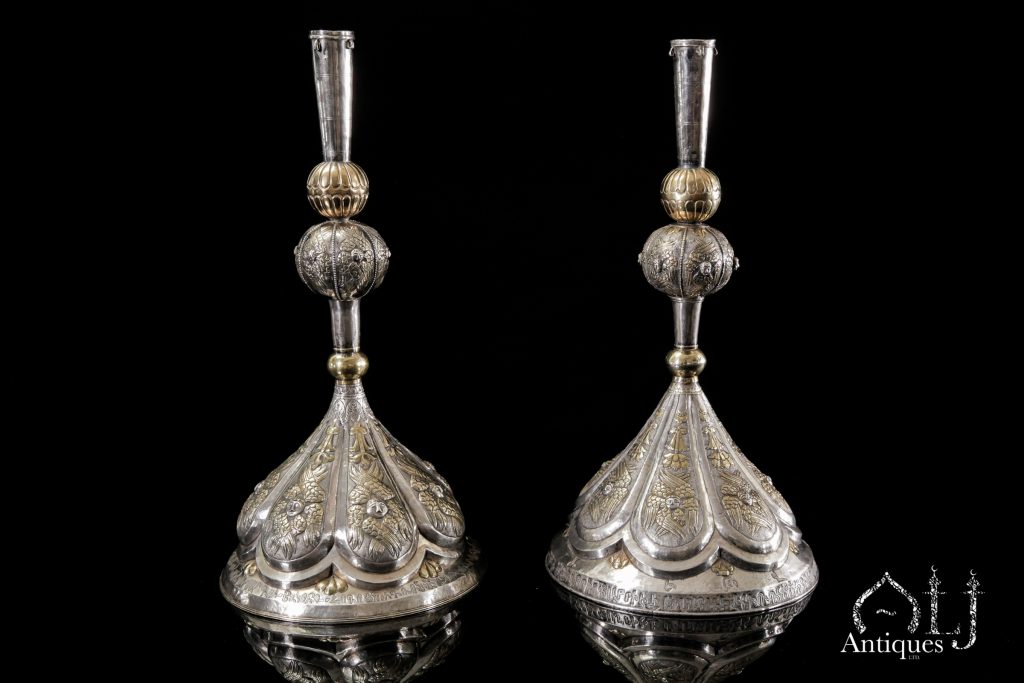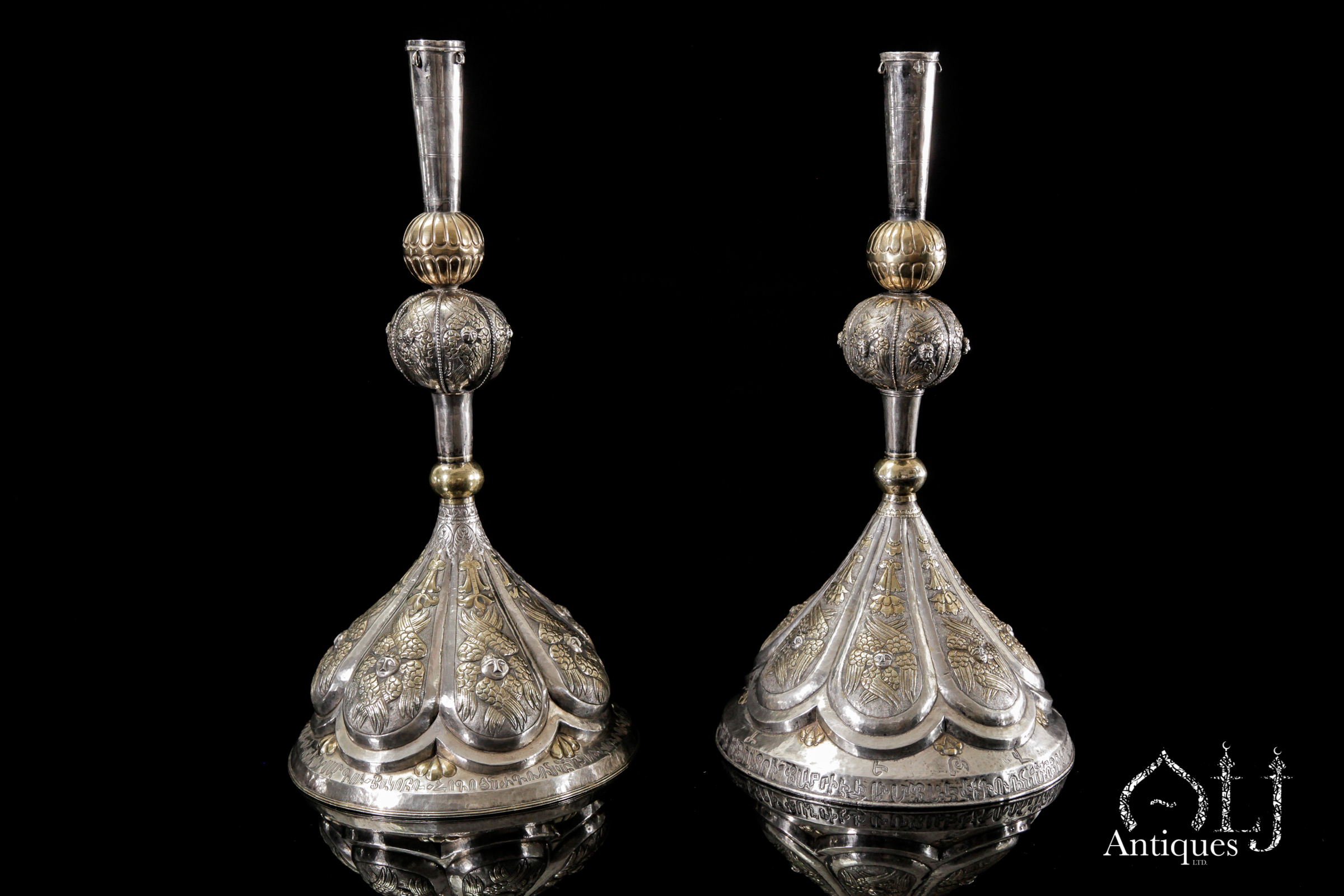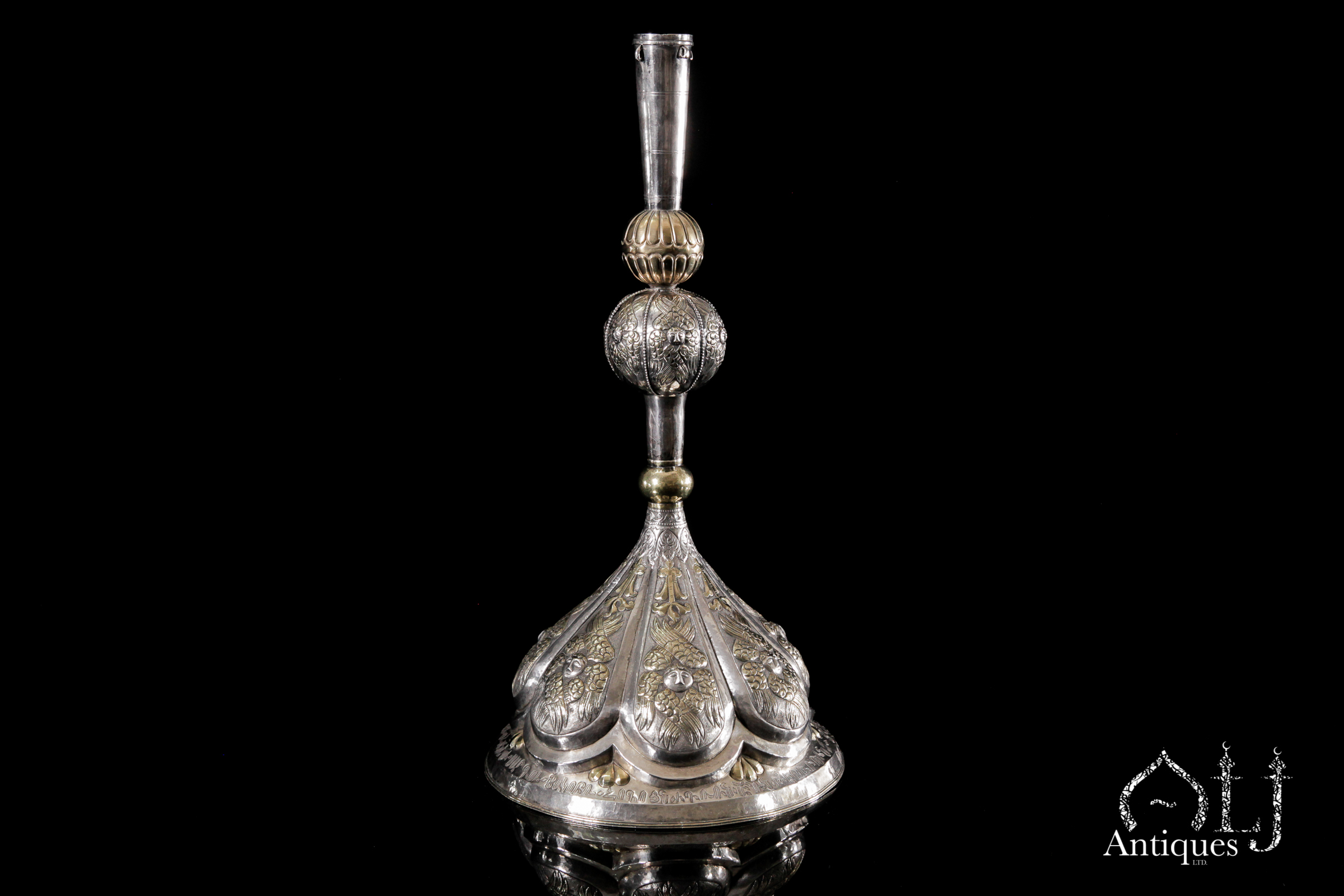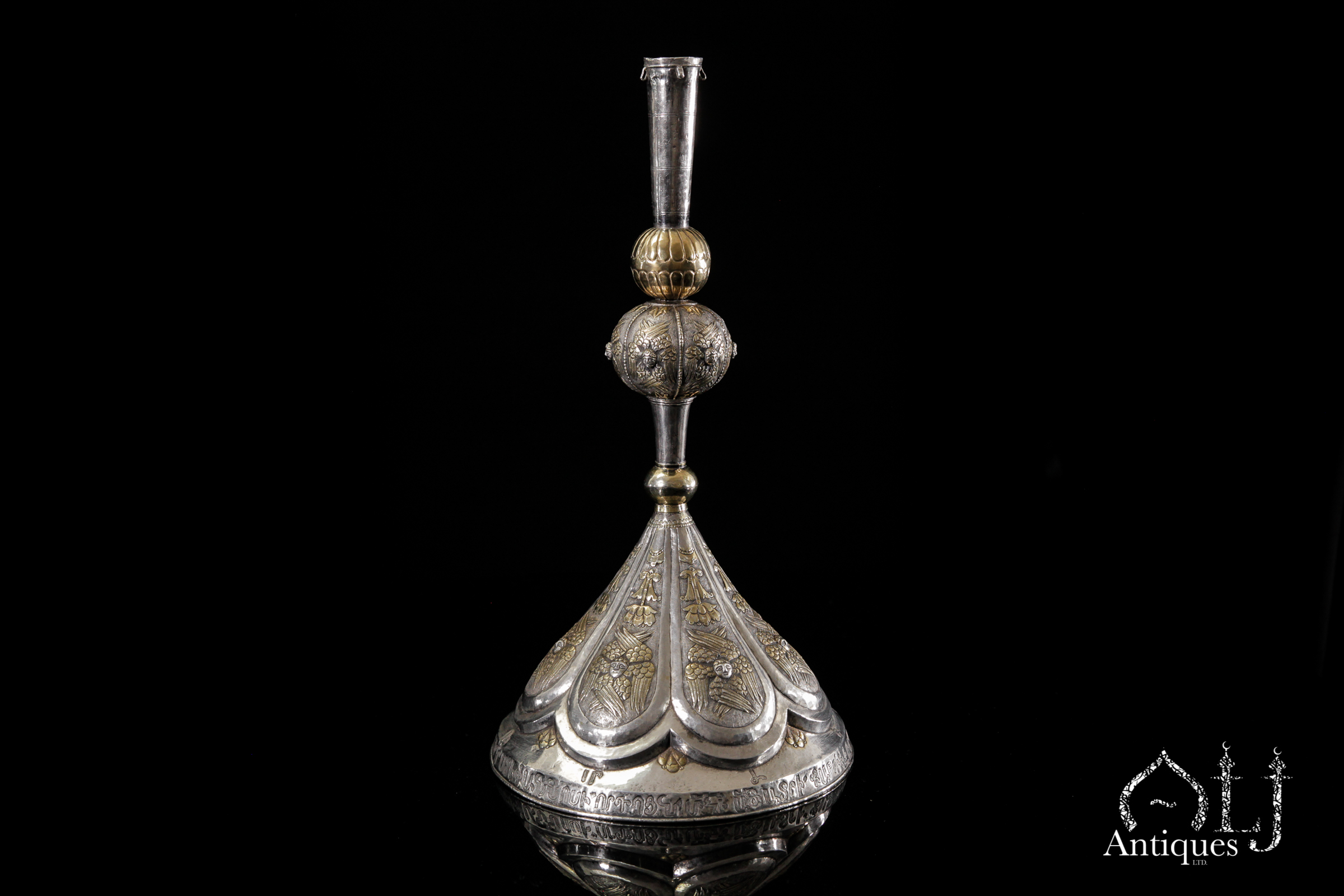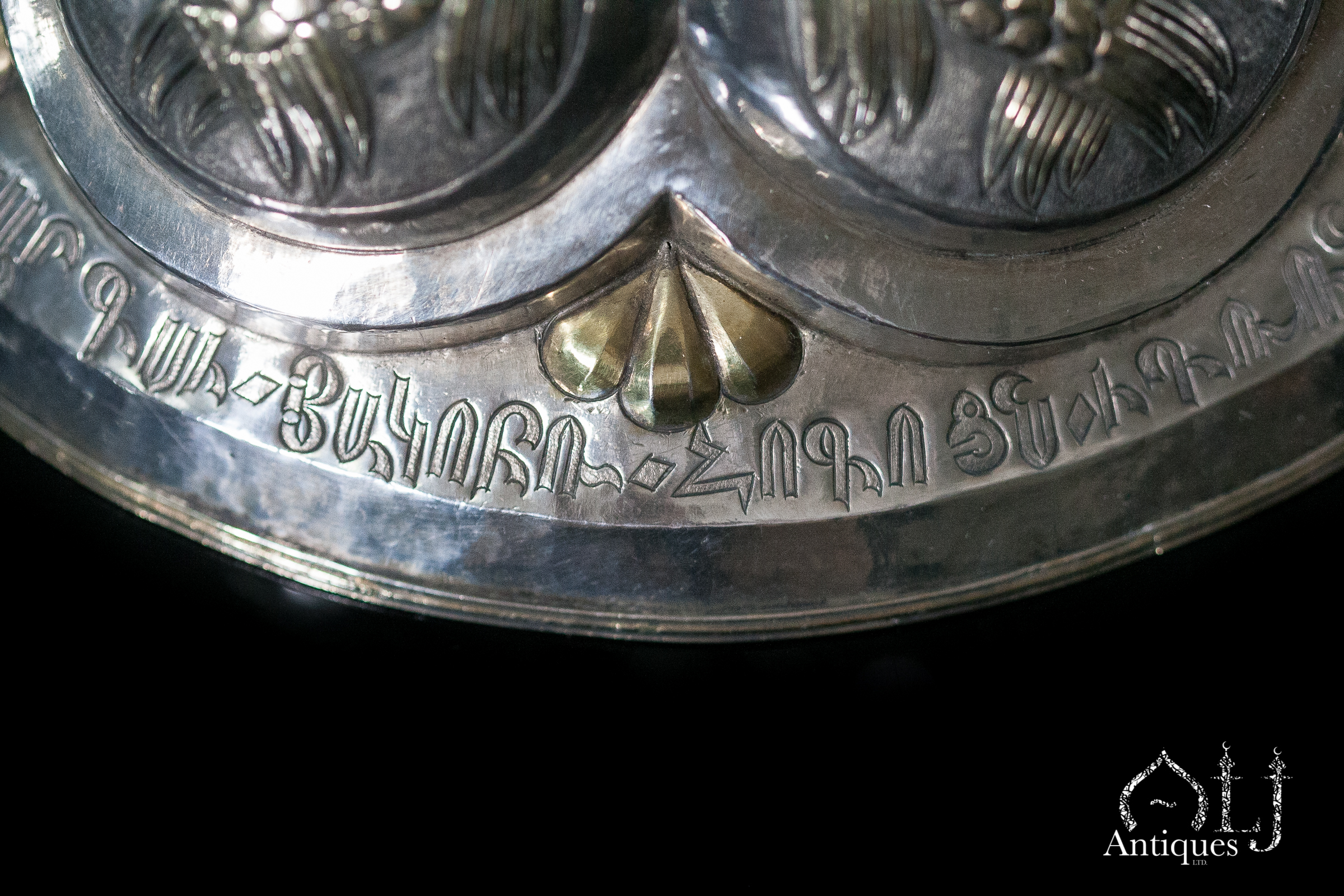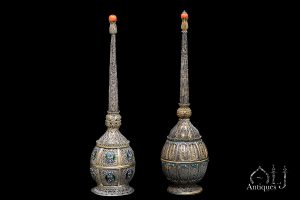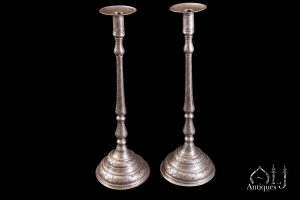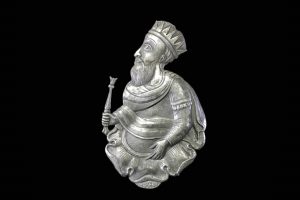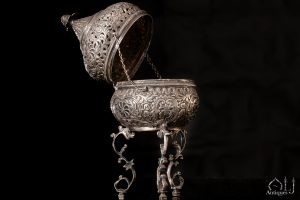Description
A Close Pair of Armenian Repoussé Parcel-Gilt Silver Candlesticks
Origin: Ottoman Empire, Istanbul
Period: Dated 1214-15 (Armenian Calendar) / 1765-66 AD
Material: Parcel-Gilt Silver.
This exceptionally rare and significant close pair of Armenian parcel-gilt silver candlesticks was crafted to commemorate the initiation ceremony of Armenian pilgrims journeying to the Holy Lands in Jerusalem and Bethlehem.
This sacred and emotional tradition was upheld for centuries by the Armenian community of Constantinople, present-day Istanbul.
The ceremony took place at the gates of the historic Vefa Kilise Molla Gurani Camii (formerly the Church of Hagios Theodoros).
Historical Significance:
Originally the Church of Hagios Theodoros was built as a Greek Orthodox church in the 11th century, Hagios Theodoros was converted into a mosque following the Ottoman conquest.
The Armenians, who could no longer access the church, likely conducted this ritual as a symbolic assertion of their historical connection to the site, emphasizing their enduring ties to their sacred heritage.
These candlesticks, undoubtedly the work of an Armenian master silversmith, were privately commissioned—possibly in secret—lacking assay or silver marks from the reigning Ottoman Sultan, Mustafa III (r. 1757–1774 AD).
Design and Construction:
Each candlestick is composed of five detachable sections, allowing for ease of transport and concealment during long pilgrimages on foot or horseback.
- Base: Large, hollow domed form with a bold repoussé design, connected to the upper sections by a knop and threaded shoulder.
- Stem: Elongated, hollow column culminating in a tulip-shaped shoulder.
- Capital/Sconce: Cylindrical design, completing the structure with elegant Armenian motifs.
This exceptionally rare and important close pair of Armenian parcel-gilt silver candlesticks was made to commemorate the initiation ceremony of the gathering of the Armenian congregation of the pilgrims heading to the Holy Lands in Jerusalem and Bethlehem at what probably was a traditional religious and emotional practice that was probably carried out for centuries by the Armenian community who had lived in the city of Constantinople, currently the city of Istanbul in Turkey of which was taking place at the outer gates of the Vefa Kilise Molla Gurani Camii or (mosque).
The Vefa Kilise Molla Gurani Camii was originally a very important Greek Orthodox church, the church of Hagios Theodoros located at the Byzantine quarter of Istanbul which is thought to had been built during the 11th century and had continued to be so until the fourteenth century when the church had been later converted after the Islamic-Ottoman conquest of the city of Constantinople into a mosque or the Vefa Kilise Molla Gurani Camii, which is believed that the conversion was made by Sheikh Al-Islam Mullah Gorani or Gurani during the reign of the Ottoman Sultan Mehmed II or Bayezid II.
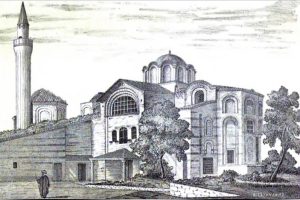
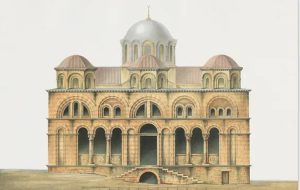
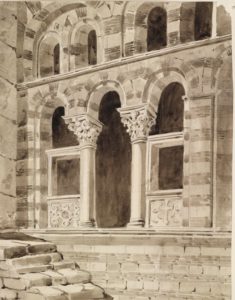
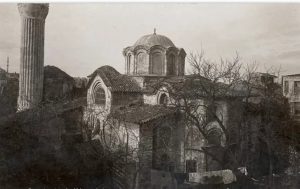
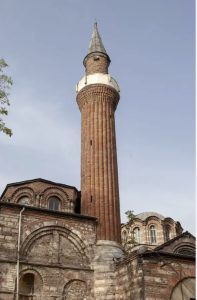
This kind of tradition which was carried out by the Armenian pilgrims and at the doors of what was used to be the church of Hagios Theodoros which they can no longer have access to or practice their Christian faith in for it had been turned into a mosque and this practice is believed to be some kind of a symbolic emphases of the community rightfulness to the holly place where their ancestors had originally built, practice their faith and potentially where they were also had been buried.
The very bold and beautifully engraved Armenian script on both round bases of the candlesticks clearly shows the names of the donors and the pilgrims who were going to visit the holly lands from the city of Istanbul to the holly lands in Jerusalem and Bethlehem (although the Armenian script does not mention visiting the city of Bethlehem, but visiting the Holly site by the pilgrims were inevitable), interestingly enough the names of the deceased persons were also mentioned and the names of the people who were going to do the pilgrimage on their behalf.
Each candlestick comprises of two detachable sections with each end had been converted into a threaded screw which can be threaded or inserted into the other section, this make the candlestick smaller and the different parts can be kept or hidden separately and safely whilst travelling on the various methods available at the time such as the combination of travelling for long distances on foot or on the back of the animals.
Also, there is an additional interesting fact that the Armenian script engraved on the base, shows that the bases were intended to carry or hold a Holly crucifix probably to be donated to one of the Holly Armenian places in Jerusalem such as the to the Chapel of Saint Helena or as the Armenians calls it the Chapel of St. Gregory the Illuminator which is located at the lower section of the Church of the Holy Sepulchre in Jerusalem or to be gifted to the Armenian Apostolic Church etc.
There are many potential theories for the transformation or the use of these candlesticks, from being originally commissioned to be made as crucifix holders and had been later altered into candlesticks, this change might had been politically motivated or was made for security reasons, or the detachable upper parts which should had been made as crucifixes had stayed back at one of the churches in the holy lands and the bases were returned back to Istanbul to be later altered to usable souvenir and to be turned to candlesticks, also the alteration could had happened in the holy lands in Jerusalem, but most likely the reason for the alteration will remain for the future to be resolved?
The following are some of the translations of the Armenian script found on both bases of the candlesticks:
Candlestick No.1
The Armenian Script on Candlestick No.1
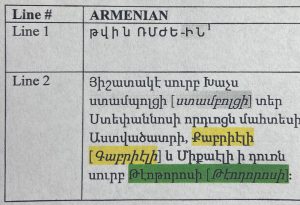
The Following is the translation to English
Line 1, In the year 1215 (of the Armenian calender, or 1766 AD.).
Line 2, Let the Holy Cross commemorate the sons of Fr. Stepannos of Stampol (Istanbul), the Pilgrims to Jerusalem Astvatsatur, Kabriel (Gabriel) and Mikael in front of the Door of St. Theodoros (Theodoros).
Candlestick No.2
The Armenian Script on Candlestick No.2
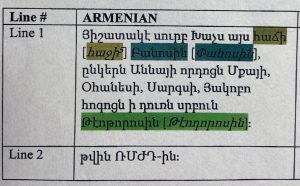
The Following is the translation to English
Line 1, Let this Holy Cross commemorate the Pilgrim to Jerusalem Banos (Panos) who is the friend of the sons of Ana-Mka, Ohanes, Sargis and Jakob-and let it commemorate their souls in front of the door of St. Theotoros (Theodoros).
Line 2, In the year 1214 of the Armenian calendar or 1765 AD.).
Notably, the inscriptions suggest that the bases were intended to hold a crucifix, possibly to be donated to significant Armenian religious sites such as the Chapel of Saint Helena (St. Gregory the Illuminator) within the Church of the Holy Sepulchre in Jerusalem.
Inscriptions and Symbolism:
The round bases of the candlesticks are engraved with Armenian script, commemorating the pilgrims and donors.
This includes references to deceased individuals for whom the pilgrimage was undertaken.
Why This Piece Stands Out:
This rare pair of candlesticks reflects the profound spiritual and historical legacy of the Armenian community under Ottoman rule.
The craftsmanship, inscriptions, and detachable design highlight their devotional significance and cultural resilience.
Perfect for collectors and institutions, these candlesticks serve as tangible relics of Armenian religious heritage and Ottoman-era artistry.

